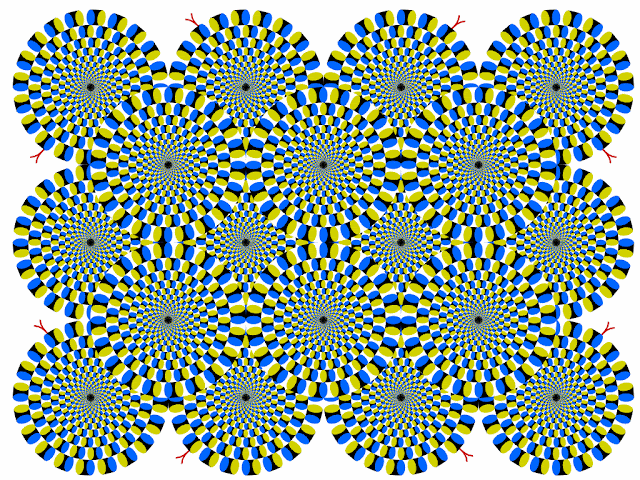In this topic, long time stare will make you feel bad. Be careful.
I'm sorry for publish too big picture. But if this picture is smaller than this one, this picture can't make illusion.
This is called "Rotating Snakes". It is made by Akiyoshi Kitaoka. He is a psychologist and a professor in Ritsumeikan University. Furthermore, he is a graduate of the department of biology in Tsukuba University.
Can you believe your eyes? This is just a statics image. But the circles looks to be rotating.
Next one is "Pine cone". This looks ordinary picture. But it also have illusion. Well, please take a picture of this by your cell phone or something. And move this picture up and down or right and left. So the center pine cone moves! If you move this picture up and down, the pine cone moves right and left. If you move this picture right and left, the pine cone moves up and down.
This picture is very beautiful, isn't it? It is called "Warp". Stare at the center of this picture. Can you see the dots on the whirling pattern twinkling? If you think so, it is wrong. In fact, the dots are just colorful dots.
This is called "zigzag worms". It is just a pattern of lozenge. But the first and the third from the top objects look like moving toward right, and the second and the forth look like moving toward left.
Why these illusion happens? Akiyoshi Kitaoka gives some conclusion of the reason of illusion.
Below picture is classification of moving illusion made by Mr.Kitaoka.
observed in the peripheral vision
observed in the peripheral vision and the near-peripheral vision
observed in the peripheral vision and the near-peripheral vision
observed in the central vision and the near peripheral vision
And why do we think that "Rotating Snakes" is rotating? So far scholars think the movement of eyes that cross the picture slowly makes the illusion of rotating.
But Barrow neurology laboratory found that eyes' fine movement and a blink make the illusion.
To result this conclusion, the scholars conduct the following experiment: there are eight subjects, and they push a button when they feel Rotating Snakes don't move. Then, one fact was revealed. When Rotating Snakes began to move, their eyes moved so quickly that it is hard to be recognized (it is called saccade) or blinking. On the other hand, when Rotating Snakes stop, their eyes kept stability state.
The last picture is "Bergen illusion". This is ordinary checked pattern. But if you stare at this pattern, many black dots appear in the intersections. Interestingly, if you stare at one intersection, a black dot doesn't appear in the intersection. It is because photoreceptors that catch light restrain around stimulation. So the intersection get restraint from around passage and can be looked dark more than real. At the point you stare at, the density of photoreceptors are high. So there is little influence of restraint.
How about paintings that moves despite those are just statics images? Next week is illusion about color. Don't miss it!
But Barrow neurology laboratory found that eyes' fine movement and a blink make the illusion.
To result this conclusion, the scholars conduct the following experiment: there are eight subjects, and they push a button when they feel Rotating Snakes don't move. Then, one fact was revealed. When Rotating Snakes began to move, their eyes moved so quickly that it is hard to be recognized (it is called saccade) or blinking. On the other hand, when Rotating Snakes stop, their eyes kept stability state.
The last picture is "Bergen illusion". This is ordinary checked pattern. But if you stare at this pattern, many black dots appear in the intersections. Interestingly, if you stare at one intersection, a black dot doesn't appear in the intersection. It is because photoreceptors that catch light restrain around stimulation. So the intersection get restraint from around passage and can be looked dark more than real. At the point you stare at, the density of photoreceptors are high. So there is little influence of restraint.
How about paintings that moves despite those are just statics images? Next week is illusion about color. Don't miss it!





































